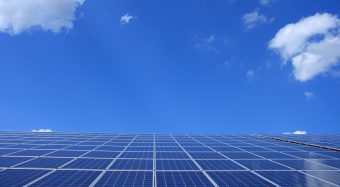
Designing and planning rooftop PV plants is one of the most challenging steps towards the realization of your dreams of having green energy produced by sunlight. Hardly any rooftop project is more demanding than designing and installing PV power plants on flat surfaces. Flat roofs are considered those inclined up to 3°, and most are covered with membranes (PVC, TPO or bitumen-based) or even concrete, so solar industry experts avoid drilling them. So, when we talk about flat roofs, we refer to low-ballast PV systems, where the mounting systems that hold the PV modules are ballasted rather than attached to the flat roof, as is the case with pitched roofs.
The concept behind the design of flat roof PV systems is to connect PV modules in groups, using their weight and ballast to resist wind forces – as a group. The solar industry developments have shown that the most optimal inclination of PV modules on flat roofs is 10° and 15°, which have recently become industry standards. This means a more aerodynamic system requiring less ballast than it would under an optimal inclination angle, which in a big part of Europe would be 30°.
IN FOCUS:
- From Glass Waste to Construction Material
- Prosumers – an Important Link in Serbia’s Energy Transition
- The Serbian Electricity Exchange Ensures the Highest European Standards
The most optimal PV module inclination angle thus gives way to the aerodynamic balance and, therefore, a reasonable amount of ballast that the roof structure can still withstand. Research has shown that the PV module pitch higher than 15° precipitates into exponential growth of the amount of ballast. The amount of ballast is at K2 Systems calculated using the proprietary planning software K2 BASE ON, in which all parameters that influence the structural verification of the mounting systems on flat roofs are factored in: wind speed, snow load, terrain category (as per Eurocode norm), building height, eaves parapet height, roof pitch and friction coefficient between the roof membrane and the mounting system itself which must be measured each time on-site.
Like in the car industry, the K2 BASE ON planning software also considers the results obtained through wind tunnel testing – a highly sophisticated procedure to obtain reference values for how the PV systems behave on a flat roof. PV systems on flat roofs must withstand all wind and snow load forces throughout the entire lifespan, which is supposed to be 30 years. To prevent potential damage to the roof membrane, these flat roof systems must also be bolstered by special rubber protection mats which protect the roof membrane. This prevents the PV system from directly rubbing onto the membrane during vibrations when wind forces occur. The biggest challenge for the PV industry in terms of flat roofs in the last years has, however, been determining the permissible inclination angle of the roofs. By what pitch is the flat roof still considered flat? As flat roof mounting solutions came last to the PV market, there was less feedback regarding the issue. The experience of the last five years has shown that the acceptable and permissible installation on flat roofs may be done on the roof pitch up to 3°.
Installations that had been executed on a pitch bigger than 3° have all shown significant problems by having the PV system being shifted or slipped away from its original position. This was pronounced when coupled with the effects of thermal expansion of the Aluminum, which is the main material of all mounting systems for PV modules. All these new insights have made producers such as K2 Systems advise installers against installations on the roof pitch higher than 3° unless the system can be somehow mechanically fixed into something or leaned against something. However, no universal recipe exists for performing the fixation and the leaning. It must be carefully examined case by case as to how to get this done. At K2 Systems, we have done it several times. However, this is possible with close cooperation with the investor and the local roofing company. Such solutions raise the project to a whole new level, and many other factors must be considered, preventing water leakage being one of them.
K2 Systems
Read the whole story in the new issue the Energy portal Magazine AGROSOLAR ENERGY AND RES.

